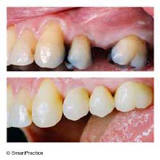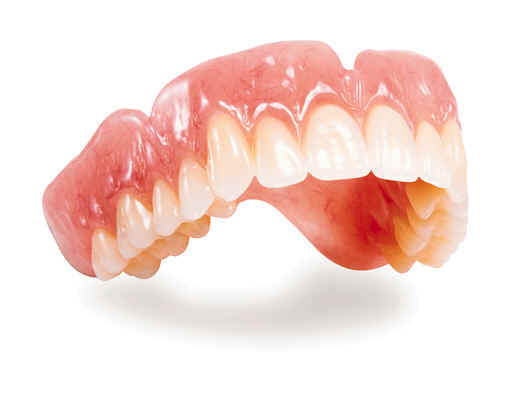Bridges & Dentures
Dentists believe that the best teeth are your own teeth. They will do all they can to make sure you keep your teeth. But sometimes, a tooth is badly damaged or lost. The good news is bridges and dentures are two ways to restore a badly damaged tooth or replace a lost tooth.

Bridges
If a tooth is lost, it is important to replace it with a false (or artificial) tooth as soon as possible. This procedure will prevent your remaining teeth from drifting out of line and causing other problems.
A bridge is also called a "fixed bridge" or a "fixed partial denture." A bridge can replace one or more missing teeth and is held firmly in place by healthy teeth on each side of the missing one(s). You cannot take a bridge out. It is permanent.

How a Bridge is Made
Step 1The teeth on each side of the missing one(s) are prepared for crowns.
Step 2
The false tooth (or teeth) and two crowns are custom-made in a dental lab as one piece.
Step 3
The unit is placed in your mouth. The crowns are cemented to your two healthy teeth on each side of the missing one(s).
A bridge should last for about 10 years, if you take good care of it. Your dentist will show you how to use a floss threader to floss under and around the false tooth (or teeth) in the middle of the bridge.
Dentures
There are two types of dentures: partial and full dentures. Both types are made in a dental lab, based on a mold (or an impression) of your mouth.
A partial denture is also called a "removable partial denture" or a "partial." It is made up of one or more false teeth, and held in place by clasps that fit onto nearby teeth. You can take the partial denture out yourself, for cleaning and at night. A partial denture may be used when nearby teeth are not strong enough to hold a bridge, or when more than just a few teeth are missing.
A full denture is also called a "complete denture" or "false teeth." It can be used when all your natural teeth are missing. Remember, you need to care for a denture as carefully as you would look after your natural teeth.

How to Care For Dentures
Step 1: Keep your denture clean.
Plaque builds up on a denture just like it does on natural teeth. Unless plaque is removed from your denture, it can spread to your natural teeth and gums, causing gum disease and cavities.
Step 2: Remove your denture every night.
Brush your natural teeth and your gums carefully with a soft toothbrush. If your toothbrush hurts you, run it under warm water to make it softer, or try using a finger wrapped in a clean, damp cloth.
Step 3: Soak your denture overnight.
It can be soaked in a special cleaner (called denture cleanser), in warm water or in a half-and-half mix of warm water and vinegar. If your denture has metal clasps, soak it in warm water only. Soaking will loosen plaque and tartar, so they will come off more easily when you brush. Brush and rinse your denture before you put it back in.
Step 4: See your dentist regularly.
Your mouth is always changing, so your denture will need adjusting from time to time to make sure it fits well. If you have a partial denture, regular check-ups are important to make sure that your natural teeth and gums get the care they need.
